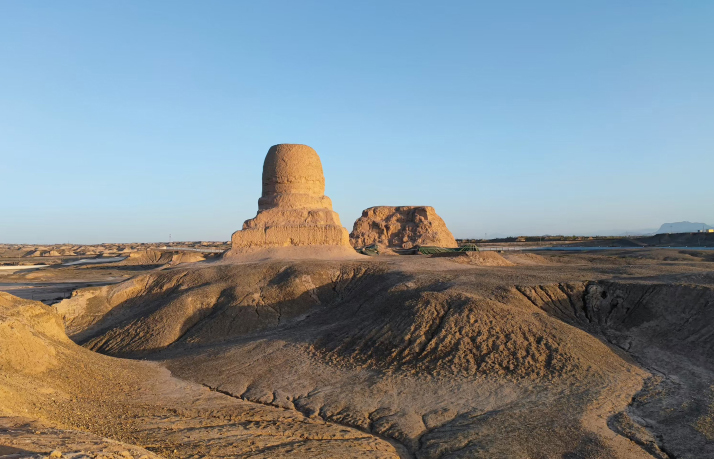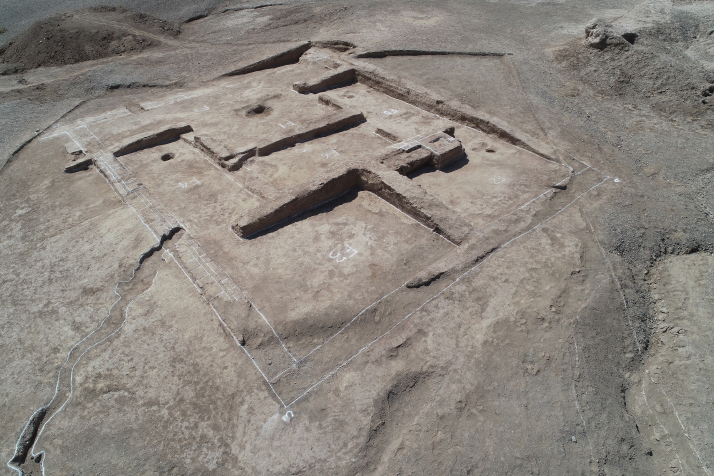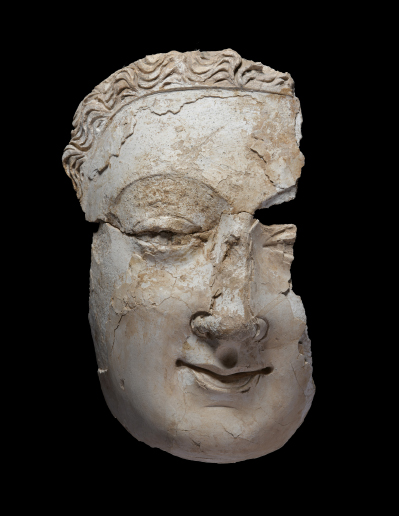| Xinjiang Today |
| Crossroads of faith | |
|
|
 An undated photo of the Mo'er Temple site outside Mo'er Village in Kashi, Xinjiang Uygur Autonomous Region (XINHUA)
'After six years dedicated to understanding the roughly 2,000-year-old Mo'er Temple site, we found our effort has been profoundly rewarding!" Xiao Xiaoyong, an archaeology professor at Minzu University of China, told Xinjiang Daily on April 24. His joy stemmed from the announcement that the Mo'er Temple site in Kashi, also known as Kashgar, Xinjiang, had been recognized as one of the top 10 archaeological discoveries of 2024. Xiao emphasized that numerous unsolved mysteries surrounding the temple continue to fuel his passion for further exploration. The Mo'er Temple site is the westernmost and best-preserved earthen Buddhist temple discovered in China to date. It stands as a prime example of early, large-scale Buddhist temples in China and the Sinicization of Buddhism. The judging panel of experts lauded the site for its relatively complete structural layout, diverse range of temple buildings, early origins, and long period of continuous use. They highlighted its value in providing rich and vivid materials for understanding the spread of Buddhism in Xinjiang after its initial introduction to China and the subsequent process of Sinicization.  Excavation site of Building No.1 at the Mo'er Temple site in Kashi (XINHUA)
Discovering the past In 2019, the Beijing-based Minzu University of China, in partnership with the Xinjiang Institute of Cultural Relics and Archaeology, launched an archaeological excavation of the Mo'er Temple site. Prior to leading the team to the site, Xiao had already undertaken numerous solo reconnaissance trips to the location. "Historical information about the Mo'er Temple site is scarce," Xiao explained. "Aside from the two pagodas—one square, one round—perched atop a high platform, there were no visible remains in the surrounding area. What lay buried beneath the sand and soil was a complete mystery, with no historical records to offer guidance. The fundamental questions we faced were 'Where do we begin and how do we start?'" He described how he frequently traveled between Xinjiang and Beijing, sharing his observations and brainstorming ideas with experienced archaeologists. The name "Mo'er," meaning "chimney" in the Uygur language, was applied to the pagodas due to their resemblance to chimneys. Following the establishment of the People's Republic of China in 1949, the Mo'er Temple site garnered the attention of cultural heritage authorities. During the second (1980s) and third (2007-11) National Cultural Relics Censuses, cultural heritage workers meticulously surveyed and mapped the site's pagodas and surface features, documenting and preserving crucial data. In 2001, the site's significance was formally recognized with its designation as a major historical and cultural site protected at the national level. Excavations were greatly aided by experts from the Kashi Cultural Heritage Department and the Kashi Museum, who provided invaluable support to Xiao. "They accompanied me on numerous trips to the site, focusing on a single crucial decision: where to begin digging. We carefully weighed feasibility, taking into consideration artifact safety and other critical factors," Xiao explained. Ultimately, a peripheral area surrounding the pagodas was selected for initial excavation. A breakthrough soon followed. Just over two weeks into the dig, fragments of plaster Buddha statues began to emerge from the compacted sand and soil. This discovery thrilled Xiao and his team. "It became clear that significant remains awaited discovery, finally dispelling the uncertainty that had weighed on us," Xiao recounted.  A giant plaster Buddha face unearthed at the Mo'er Temple site (XINHUA)
Multicultural integration Beyond the rich fragments of plaster Buddhist statues, archaeologists have unearthed a diverse array of artifacts at the Mo'er Temple site, including items made of pottery, bronze, stone, wood, bone, and textiles. Coins dating back to the Han (202 B.C.-A.D. 220) and Tang (618-907) dynasties have also been found. In total, over 30,000 artifacts have been unearthed in six excavations. "Among the numerous artifacts, a fragment of a plaster Buddha statue face stands out, showcasing a fusion of Gandharan and Central Plains Buddha statue styles—a prime example of multicultural integration," Xiao noted. Gandhara, an ancient region in northwest Pakistan, was a prominent center of Buddhist art and culture. The Central Plains—comprising modern-day Henan, southern Hebei, southern Shanxi, and western Shandong provinces—historically served as the core of China's political, economic, and cultural development. "Another remarkable find is a Buddha palm measuring 41 centimeters in length, suggesting that the Buddha statues of the time were twice the size of an average person, highlighting the impressive scale of Mo'er Temple." These were just some of the moments of awe and astonishment Xiao experienced during the six years of excavation. The artifacts owe their preservation to Mo'er Temple's construction on a high platform. Over millennia, wind and rain erosion caused the collapse of many structures, including sections of the pagodas. The resulting soil runoff covered and protected numerous artifacts, ensuring their survival to the present day. Archaeological excavations in 2024 revealed that the site is primarily distributed across two adjacent terraces, representing a complete monastic building complex. Archaeologists have uncovered the foundations of two pagodas, as well as 18 distinct buildings, including monks' dormitories, cloister-style Buddhist halls, rectangular Buddhist halls, preaching halls, and kitchens—comprising 62 rooms in total—and two stepped walkways connecting the various structures. Carbon dating indicates that the site was established in the first century and abandoned around the late ninth and early 10th centuries. During the first to third centuries, the round pagoda served as the site's center, accompanied by structures like walkways and monks' dormitories. In the fourth century, as the number of monks at Mo'er Temple increased, Buddhist halls, kitchens, preaching halls, and the square pagoda were progressively constructed. This reflected the Buddhist architectural style of the Central Plains, with the site's center evolving into a combination of pagodas and Buddhist halls. "The latest excavation further clarifies the timeline of Mo'er Temple's rise and fall, and sheds light on the layout, structure, and function of the Buddhist temple," explained Wang Yongqiang, an associate researcher at the Xinjiang Institute of Cultural Relics and Archaeology, to Xinjiang Daily. "This is a rare discovery and offers invaluable material for studying the Sinicization of Buddhism." The Buddhist remains at the Mo'er Temple site, particularly those dating to after the fourth century, clearly illustrate the integration of diverse cultural influences, including those from India, Central Asia, Gandhara, and the Central Plains with the culture of the local Western Regions. From the Han Dynasty to the middle and late Qing Dynasty (1644-1911), the vast areas both north and south of the Tianshan Mountains in Xinjiang were referred to as the Western Regions. "The Buddha statues from different periods exhibit variations in height, size, facial features, expressions, hairstyles, clothing, and accessories," Xiao explained. "Some feature 'high noses, thick eyebrows, and deep eyes,' while others display 'thin eyebrows, long eyes, and round faces,' demonstrating how Buddhism continuously absorbed and integrated new elements after its introduction into China." These Buddha statues attest to the process of Sinicization that Buddhism underwent as it entered the Western Regions. Consequently, Xiao argues that the Mo'er Temple site serves as compelling evidence of the inclusiveness of Chinese civilization. In 2024, the archaeological team unearthed a significant new find: a mud tile reflecting Central Plains architectural culture. This artifact offers a valuable clue, suggesting that the construction methods employed at Mo'er Temple were influenced by the Central Plains. "This mud tile provides important evidence that Mo'er Temple was a large Buddhist temple built by the Central Government," Xiao stated. "It also serves as proof of the Central Government's effective control over the Western Regions during that period." "The archaeological research at the Mo'er Temple site is now transitioning to the phases of data collation, report writing, and research interpretation, establishing a solid foundation for the site's future presentation and utilization," Wang stated. After six years of excavation, archaeologists have gained a relatively comprehensive understanding of the site's historical evolution, architectural techniques and characteristics, and the process of Buddhist dissemination. The next critical step involves leveraging the research and interpretation of the unearthed artifacts to effectively tell the story of the Mo'er Temple site. Comments to jijing@cicgamericas.com |
|
||||||||||||||||||||||||||||
|